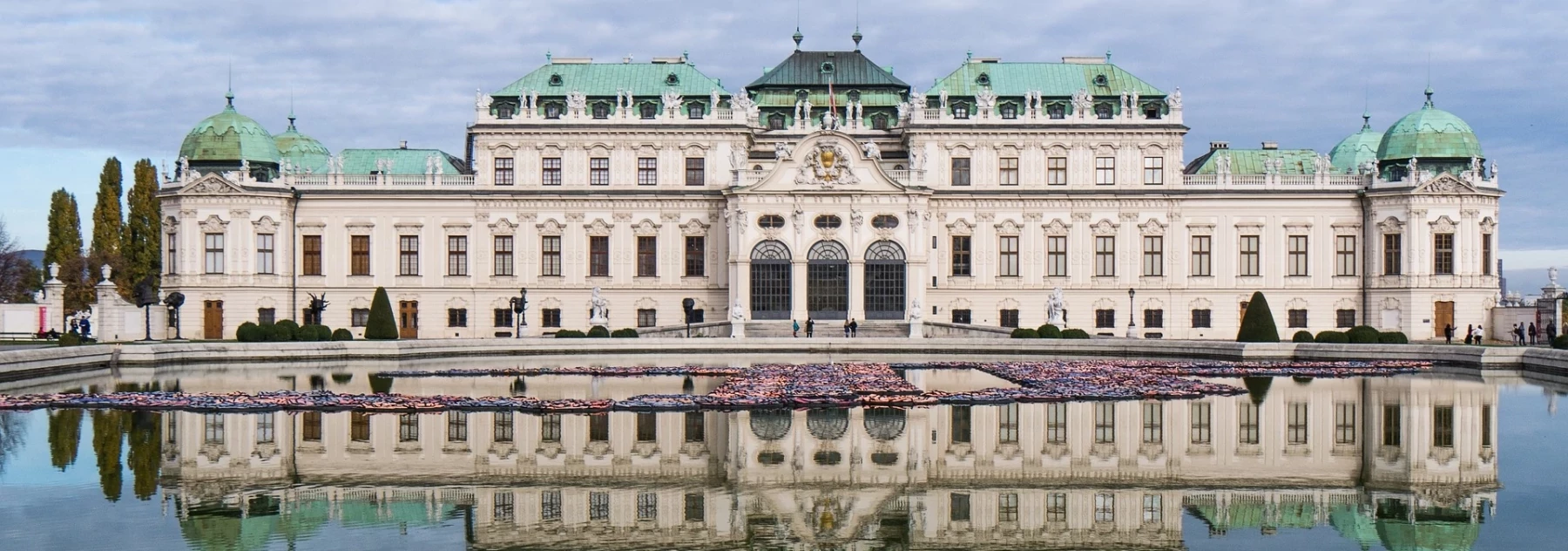To visit - Vienna
Welcome to Vienna, the city where history meets elegance, where music resonates through cobblestone streets, and where every corner reveals a new treasure to uncover.
Picture yourself strolling through the narrow alleys of the city center, steeped in centuries of imperial history. Magnificent baroque palaces stand proudly, reminiscent of the opulence of the ancient Habsburg dynasty. Schönbrunn Palace, the summer residence of the imperial family, transports you to a world of splendor and extravagance, with its French gardens and sumptuously decorated halls.
Art and music are at the heart of Vienna. Wander through the museum quarter, where masterpieces by Klimt, Schiele, and other great Austrian masters await. Attend a concert in one of the many world-renowned concert halls, where the notes of Mozart, Beethoven, and Strauss continue to enchant audiences.
But Vienna is not limited to its glorious past. It is also a dynamic city where contemporary culture thrives. Traditional cafes are lively meeting places, where you can savor a delicious Viennese coffee while watching the world go by.
And let's not forget Viennese cuisine. Sample the delights of Austrian cuisine in traditional restaurants, where crispy schnitzel and delicate pastries await you at every turn.
Whether you're a history buff, a music lover, an art enthusiast, or a foodie, Vienna will enchant you with its timeless charm and rich cultural heritage. Prepare to be transported to a world of beauty and inspiration, where every moment is an invitation to discover. Welcome to Vienna, where the journey becomes an unforgettable experience.
The 19 essential things to do in Vienna :
Summary
- To visit
-
- 1 - Schönbrunn Palace
- 2 - Saint-Étienne Cathedral
- 3 - Vienna State Opera
- 4 - Art History Museum and Natural History Museum
- 5 - Belvedere
- 6 - Albertina Museum
- 7 - Prater of Vienna
- 8 - Schönbrunn Palace
- 9 - The Danube and the Danube Canal
- 10 - Vienna City Park (Stadtpark)
- 11 - The Imperial Crypt
- 12 - The Imperial Treasure
- 13 - The Mozarthaus Museum
- 14 - Hundertwasser's House
- 15 - The Austrian National Library
- 16 - Attend a classical music concert
- 17 - Explore Viennese cafés
- 18 - Take a carriage ride
- 19 - Taste Austrian cuisine
- Vienna - Where to Stay?
- Vienna - How to get around?
- Vienna - Best period
1 - Schönbrunn Palace
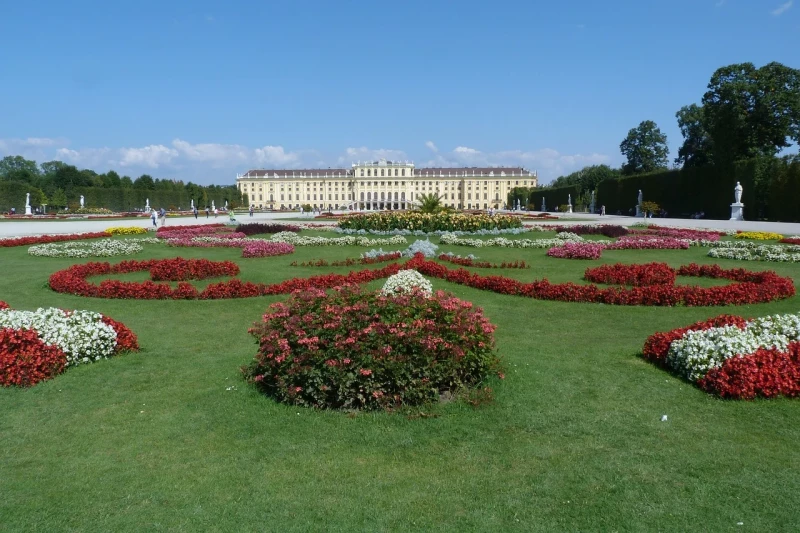
Schönbrunn Palace, located in Vienna, Austria, is one of the most important cultural and historical landmarks in the country. It was initially built as a hunting lodge in the late 17th century and was later expanded into a magnificent imperial palace during the reign of Empress Maria Theresa in the 18th century.
The palace is renowned for its stunning Baroque architecture, vast gardens, and rich history. It served as the summer residence of the Habsburg monarchs, including Emperor Franz Joseph and Empress Elisabeth (commonly known as Sisi).
Visitors to Schönbrunn Palace can explore the lavish state rooms, including the Great Gallery, the Mirror Room, and the Vieux-Laque Room, which are adorned with intricate decorations, frescoes, and exquisite furniture. The palace also houses a collection of valuable art, porcelain, and other historical artifacts.
The palace gardens are equally impressive, featuring beautifully landscaped grounds, fountains, sculptures, and a charming maze. The Gloriette, a magnificent structure perched atop a hill overlooking the palace, offers panoramic views of the surrounding area.
Today, Schönbrunn Palace is a UNESCO World Heritage Site and one of Vienna's most popular tourist attractions, drawing millions of visitors each year who come to marvel at its beauty and immerse themselves in its rich history. Additionally, the palace hosts cultural events, concerts, and exhibitions throughout the year, further adding to its allure.
2 - Saint-Étienne Cathedral
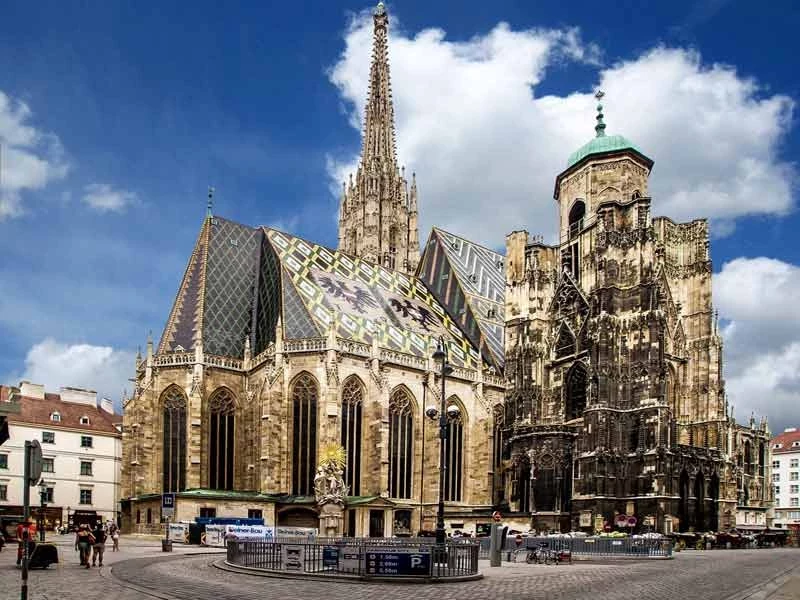
The St. Stephen's Cathedral, also known as Stephansdom in German, is one of the most iconic churches in Vienna, Austria. Located in the heart of the city, it stands as a symbol of Austrian history and culture.
Construction of the cathedral began in the 12th century, though it has been modified and expanded several times over the centuries. It features a mix of architectural styles, including Romanesque and Gothic, as well as Baroque and neo-Gothic elements added over time.
St. Stephen's Cathedral is renowned for its characteristic spire, which rises over 135 meters (nearly 450 feet) and dominates Vienna's skyline. Visitors can also admire the magnificent stained glass windows, intricately decorated altars, sculptures, and frescoes that adorn the interior of the church.
In addition to its religious significance, the cathedral has played a crucial role in Vienna's history. It has been the site of coronations for many Austrian monarchs, as well as royal weddings and other important ceremonies.
Today, St. Stephen's Cathedral remains an active place of worship, but it is also open to visitors who wish to explore its fascinating history, architectural beauty, and enjoy the panoramic views from its tower. It is one of Vienna's most popular tourist attractions, drawing visitors from around the world.
3 - Vienna State Opera
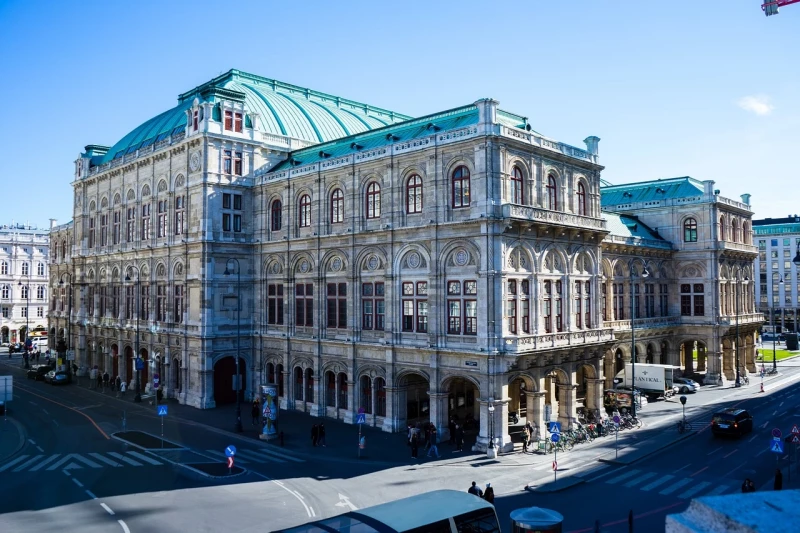
The Vienna State Opera, known as the Wiener Staatsoper in German, is one of the most prestigious opera houses in the world. Located in the heart of Vienna, Austria, it is renowned for its rich history, stunning architecture, and world-class performances.
The Vienna State Opera was inaugurated in 1869 with a performance of Mozart's "Don Giovanni". Since then, it has been at the forefront of the opera world, showcasing the talents of renowned composers, conductors, singers, and musicians.
The opera house itself is an architectural masterpiece, blending elements of Renaissance, Baroque, and Neo-Renaissance styles. Its grand facade and opulent interiors reflect the cultural and artistic richness of Vienna.
The Vienna State Opera hosts a diverse repertoire, featuring classics from the operatic canon as well as contemporary works. It is particularly famous for its productions of operas by composers such as Mozart, Strauss, Wagner, Verdi, and Puccini.
In addition to opera performances, the Vienna State Opera also stages ballet productions and classical concerts, further enriching Vienna's cultural landscape.
Attending a performance at the Vienna State Opera is a memorable experience for visitors and locals alike, offering the opportunity to immerse oneself in the timeless beauty of opera and witness world-class artistry in a breathtaking setting.
 Our tips for getting the most out of your experience.
Our tips for getting the most out of your experience.
If you're planning to visit the Vienna State Opera, here are some tips to make your experience as enjoyable and enriching as possible:
-
Book your tickets in advance: Shows at the Vienna State Opera are often in high demand, so it's recommended to book your tickets as early as possible to secure the best seats.
-
Explore guided tours: The opera offers guided tours that allow you to explore backstage areas, costumes, sets, and the fascinating history of this iconic venue. It's a great way to learn more about its inner workings and cultural heritage.
-
Take advantage of special offers: The Vienna State Opera sometimes offers special deals for performances, including discounts for students, youths, and groups. Make sure to check for available offers before purchasing your tickets.
-
Arrive early: To fully enjoy your visit, arrive at the opera house early to soak up the atmosphere, explore the surroundings, and take photos of this beautiful building.
-
Dress appropriately: While not mandatory, it's common to dress elegantly when attending a performance at the Vienna State Opera. This adds to the special ambiance of the event.
-
Explore the surroundings: The opera house is located in a lively area of Vienna, filled with restaurants, cafes, and shops. Take advantage of your visit to explore the surroundings and sample the local cuisine.
-
Respect rules and traditions: During performances, it's important to respect conduct rules, such as refraining from taking photos or disrupting the show by talking or using electronic devices.
By following these tips, you'll be able to fully enjoy your visit to the Vienna State Opera and have an unforgettable experience at the heart of Viennese culture.
4 - Art History Museum and Natural History Museum
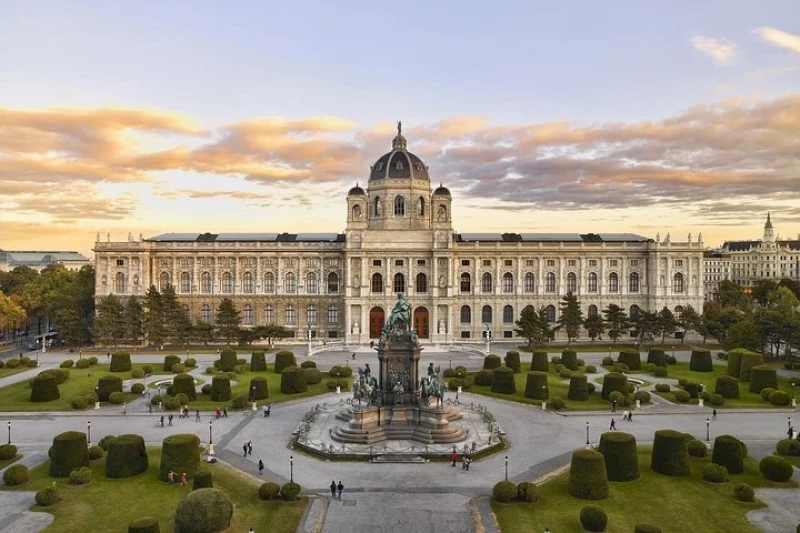
The Museum of Art History (Kunsthistorisches Museum) and the Museum of Natural History (Naturhistorisches Museum) are two magnificent museums located in Vienna, Austria, and they are often referred to as sister museums due to their similar architectural styles and close proximity to each other.
-
Museum of Art History (Kunsthistorisches Museum):
- Art Collections: The Kunsthistorisches Museum houses an extensive collection of fine art from various periods, including works by famous artists such as Raphael, Rembrandt, Vermeer, and Titian.
- Egyptian and Near Eastern Collection: It boasts one of the largest and most significant collections of Egyptian and Near Eastern antiquities in the world, featuring mummies, sculptures, and artifacts.
- Antiquities Collection: The museum also has an impressive collection of classical antiquities, including Greek and Roman sculptures, vases, and jewelry.
- Baroque Architecture: The building itself is a masterpiece of late Renaissance and Baroque architecture, designed to showcase the grandeur of the Habsburg Empire.
-
Museum of Natural History (Naturhistorisches Museum):
- Mineralogical and Geological Collections: The Naturhistorisches Museum houses vast collections of minerals, gemstones, rocks, and fossils, providing insights into the Earth's geological history.
- Paleontological Collection: It is renowned for its extensive paleontological collection, including dinosaur skeletons, fossils, and reconstructions of prehistoric creatures.
- Botanical and Zoological Exhibits: Visitors can explore botanical displays with thousands of plant specimens, as well as zoological exhibits featuring diverse animal species from around the world.
- Architectural Splendor: Like its counterpart, the museum building is a stunning example of historicist architecture, with intricate details, grand halls, and majestic staircases.
Both museums offer a rich cultural and educational experience, allowing visitors to delve into the worlds of art, history, science, and nature. With their impressive collections and beautiful architecture, they are must-visit attractions for anyone exploring Vienna's cultural heritage.
5 - Belvedere
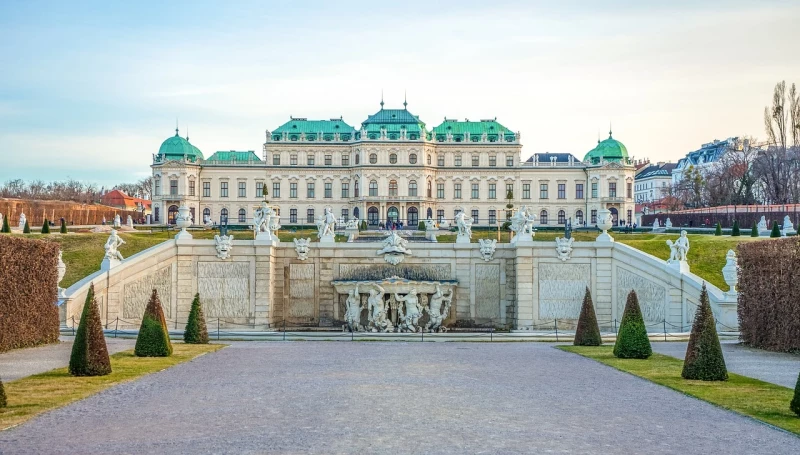
The Belvedere is a palace complex located in Vienna, Austria, and is one of the city's most important historical and cultural sites. It consists of two Baroque palaces, the Upper Belvedere (Oberes Belvédère) and the Lower Belvedere (Unteres Belvédère), as well as the Belvedere Botanical Garden and other historical buildings.
Here are some highlights about the Belvedere in Vienna:
-
Architecture: Both palaces of the Belvedere, built in the 18th century under the reign of Prince Eugene of Savoy, are remarkable examples of Baroque architecture. The Upper Belvedere, situated on a hill, offers panoramic views of Vienna.
-
Art Collections: The Belvedere houses the famous Austrian art collection, with an impressive selection of paintings and sculptures ranging from the Middle Ages to the contemporary period. Highlights include works by Gustav Klimt, including his renowned painting "The Kiss" (or "The Kiss of Judas"), as well as paintings by Egon Schiele and other Austrian artists.
-
Botanical Garden: The Belvedere Botanical Garden, located between the two palaces, is a pleasant place for a stroll and features a wide variety of plants and flowers. It also offers beautiful views of the Belvedere buildings.
-
Exhibitions and Events: The Belvedere regularly hosts temporary exhibitions showcasing various aspects of Austrian and international art. It also hosts cultural events and artistic performances throughout the year.
-
Accessibility: The Belvedere is easily accessible by public transportation from Vienna's city center. Many visitors choose to combine their visit to the Belvedere with other tourist attractions in the city, such as Vienna's historic center and Schönbrunn Palace.
In summary, the Belvedere in Vienna is an iconic destination where visitors can explore the history, art, and natural beauty of the Austrian capital.
 Our tips for getting the most out of your experience.
Our tips for getting the most out of your experience.
If you're planning to visit the Belvedere in Vienna, here are some tips to enhance your experience:
-
Buy tickets online: To avoid long lines, consider purchasing your tickets online in advance. This can save you time and ensure you have access to all areas of the Belvedere complex.
-
Visit early or late: The Belvedere can get quite crowded, especially during peak hours. To enjoy a more peaceful visit, consider going early in the morning or later in the afternoon when there are fewer tourists.
-
Take a guided tour: Guided tours are available at the Belvedere and can provide valuable insights into the history, architecture, and art collections of the palace. Check the schedule for guided tours in your preferred language.
-
Explore the gardens: Don't miss the opportunity to explore the beautiful Belvedere Gardens, especially during the warmer months. They offer a tranquil retreat from the bustling city and provide stunning views of the palace buildings.
-
Focus on highlights: The Belvedere houses an extensive art collection, so it's a good idea to prioritize the highlights if you're short on time. Make sure to see iconic works such as Gustav Klimt's "The Kiss" in the Upper Belvedere.
-
Bring a camera: The Belvedere complex offers plenty of picturesque photo opportunities, both inside and outside the palaces. Don't forget to bring your camera or smartphone to capture the beauty of the architecture and gardens.
-
Check for special exhibitions: In addition to its permanent collections, the Belvedere often hosts temporary exhibitions featuring a wide range of art and cultural topics. Be sure to check the museum's website for information on current exhibitions during your visit.
By following these tips, you can make the most of your visit to the Belvedere and fully appreciate its rich history, stunning architecture, and world-class art collections.
6 - Albertina Museum
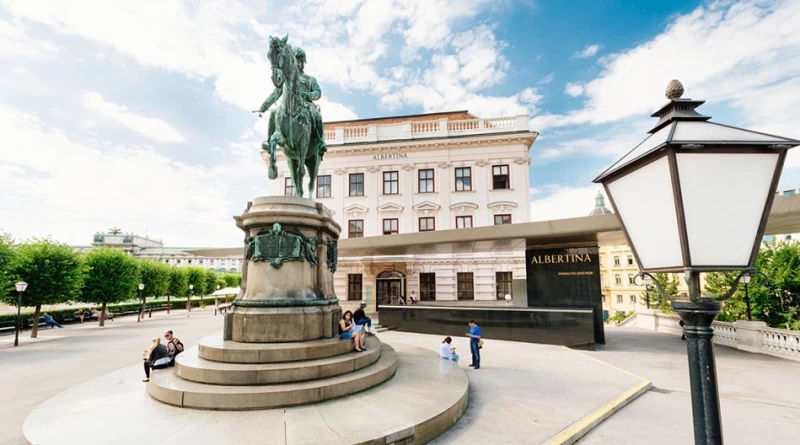
The Albertina Museum in Vienna, Austria, is one of the country's most important cultural institutions. Located in the Albertina Palace, which was once the residence of the Habsburgs, the museum houses a vast art collection, featuring works ranging from drawing and printmaking to photography and painting.
The Albertina Museum's collection of drawings is particularly renowned, including major works by masters such as Michelangelo, Dürer, Rembrandt, Rubens, and many others. In addition to drawings, the museum also hosts temporary exhibitions covering a diverse range of artistic periods and styles.
The building itself, the Albertina Palace, is an attraction in its own right, with its baroque architecture and prime location in the heart of Vienna, directly across from the famous State Opera. Visitors can also enjoy panoramic views of the city from the museum's terraces.
Whether you're a passionate art lover or simply seeking a culturally enriching experience, the Albertina Museum provides a unique opportunity to explore art history through an exceptional collection in a beautiful setting.
7 - Prater of Vienna
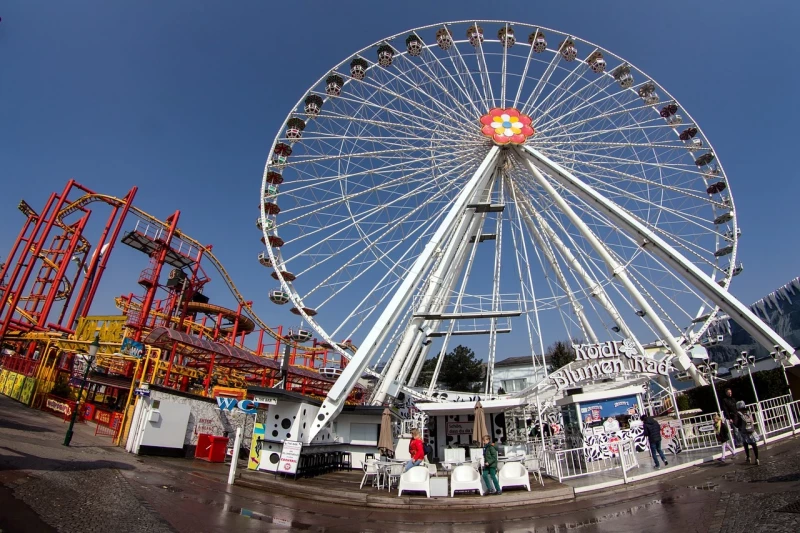
The Prater is a large public park in Vienna, Austria, famous for its iconic Giant Ferris Wheel (Riesenrad) and various other attractions. It's one of the city's most popular recreational areas, attracting both locals and tourists alike.
Originally a hunting ground for the Habsburg nobility, the Prater was opened to the public in 1766. Today, it offers a wide range of activities and entertainment options for visitors of all ages.
The most famous attraction in the Prater is the Giant Ferris Wheel, which has become an emblem of Vienna. It offers panoramic views of the city and is a must-visit for anyone exploring the area. Other notable attractions include amusement rides, such as roller coasters and bumper cars, as well as traditional Viennese restaurants and beer gardens.
The Prater is also a beautiful green space, perfect for leisurely strolls, picnics, or cycling. Its expansive meadows, tree-lined avenues, and tranquil ponds provide a welcome escape from the hustle and bustle of the city.
Whether you're seeking thrills on the rides, enjoying a leisurely walk, or simply soaking up the atmosphere, the Prater offers something for everyone and is a cherished part of Vienna's cultural heritage.
 Our tips for getting the most out of your experience.
Our tips for getting the most out of your experience.
Here are some tips for visiting the Prater in Vienna:
-
Choose the right time: The Prater can get very crowded on weekends and holidays. If possible, consider visiting on weekdays or early in the morning to avoid the crowds.
-
Plan your itinerary: The Prater is vast and has many attractions. Check a map in advance and identify the attractions you want to visit to optimize your time there.
-
Consider an attractions pass: If you plan to go on multiple rides, it may be worth purchasing an attractions pass rather than buying individual tickets. This can save you money in the long run.
-
Take advantage of off-peak hours: Off-peak hours, such as early mornings or late afternoons on weekdays, are often less crowded. This is the perfect time to enjoy the attractions without having to wait in long lines.
-
Explore the culinary diversity: The Prater offers a variety of restaurants, food stands, and cafes. Take the opportunity to sample Viennese specialties or local snacks during your visit.
-
Be prepared for the weather: Make sure you're ready for any weather conditions, especially if you plan to spend a lot of time outdoors. Bring appropriate clothing and sunscreen if needed.
-
Don't miss the Giant Ferris Wheel: The iconic landmark of the Prater is the Giant Ferris Wheel, offering spectacular panoramic views of Vienna. Be sure to take a ride for an unforgettable experience.
By following these tips, you can fully enjoy your visit to the Prater in Vienna and make it a memorable experience.
8 - Schönbrunn Palace
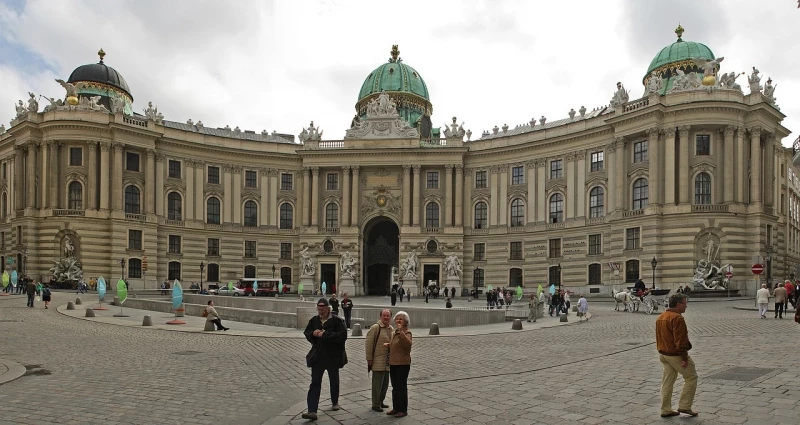
The Hofburg Palace is one of the most iconic landmarks in Vienna, the capital of Austria. This monumental complex served as the seat of power for the Habsburgs for centuries and remains today a significant symbol of Austrian history and culture.
The Hofburg was built in the 13th century and underwent continuous expansion and renovation over the centuries, reflecting the changing styles and functions of the Habsburg monarchy. The palace is a blend of architectural styles, ranging from Gothic to Baroque, Renaissance, and Neoclassicism.
The Hofburg complex houses several museums, official residences, reception halls, and the famous Spanish Riding School. It also includes the Austrian National Library and the Imperial Apartments, which offer insight into the life of the imperial family.
Today, the Hofburg serves as the official residence of the President of Austria and hosts various political and cultural events. It is a must-visit destination for visitors to Vienna, providing an immersive experience into Austria's imperial history.
9 - The Danube and the Danube Canal
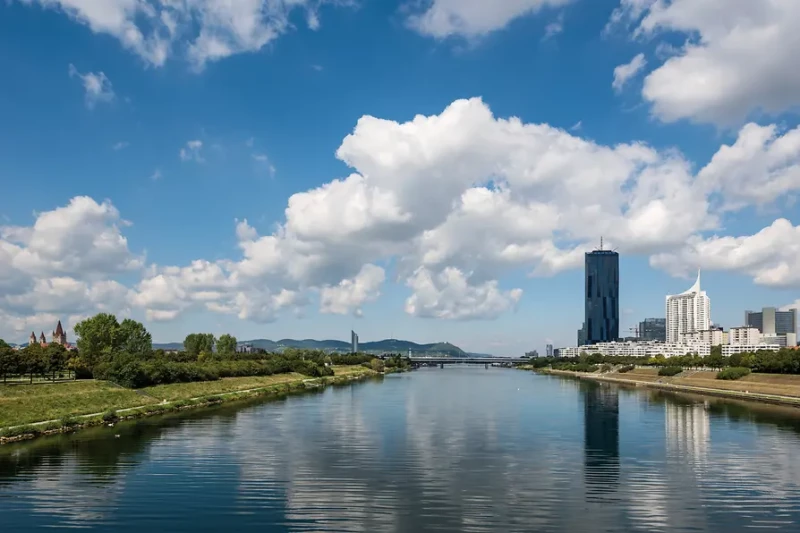
The Danube River and the Danube Canal are two significant waterways in Europe, particularly in the region of Central and Eastern Europe.
-
Danube River: The Danube is the second-longest river in Europe, flowing through ten countries: Germany, Austria, Slovakia, Hungary, Croatia, Serbia, Romania, Bulgaria, Moldova, and Ukraine before draining into the Black Sea. It originates in the Black Forest of Germany and travels over 2,800 kilometers (1,700 miles) through Central and Southeastern Europe. The Danube has played a crucial role in the history, culture, and economy of the regions it traverses. It serves as a vital transportation route for trade and commerce, and its banks are dotted with numerous cities, towns, and historical sites.
-
Danube Canal (in Vienna): In Vienna, Austria, the Danube Canal (Donaukanal) is a man-made channel that branches off from the main course of the Danube River and flows through the heart of the city. The canal was constructed in the 16th century to regulate the flow of the Danube and prevent flooding in the city. Today, the Danube Canal adds to Vienna's charm, with its picturesque waterfront promenades, trendy bars, restaurants, and cultural venues. It has become a popular recreational area for locals and visitors alike, especially during the summer months when it hosts various events and activities.
Both the Danube River and the Danube Canal hold significant cultural, historical, and economic importance for the regions they pass through, contributing to the beauty and vitality of the cities and landscapes they touch.
10 - Vienna City Park (Stadtpark)
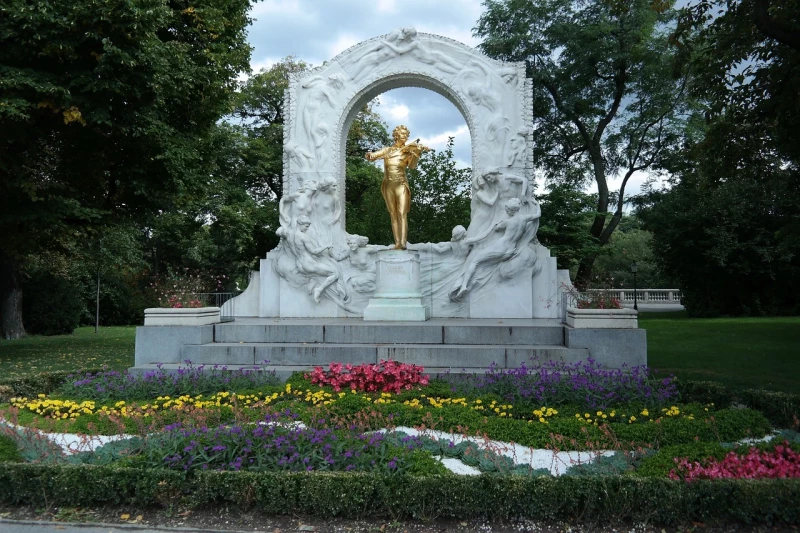
The Vienna City Park, known as Stadtpark in German, is one of the most famous and beloved parks in the Austrian capital. Located in the heart of Vienna, this historic park spans an area of 65,000 square meters and provides an oasis of greenery and tranquility amidst the urban hustle and bustle.
Stadtpark is renowned for its picturesque beauty, with vast lawns, ponds, and winding paths lined with trees. It is also home to an impressive collection of sculptures and monuments, the most famous of which is the golden statue of Johann Strauss II, the Austrian composer of classical music, which stands prominently in the center of the park.
Visitors to Stadtpark can enjoy various leisure activities such as strolling, jogging, picnicking, or simply relaxing while admiring the scenery. The park is also a popular venue for outdoor concerts, cultural events, and festivals throughout the year.
Whether for a peaceful stroll, a photo session, or simply to escape the city's hustle and bustle, the Vienna City Park offers a refreshing and enjoyable experience for both locals and visitors to the Austrian capital.
11 - The Imperial Crypt
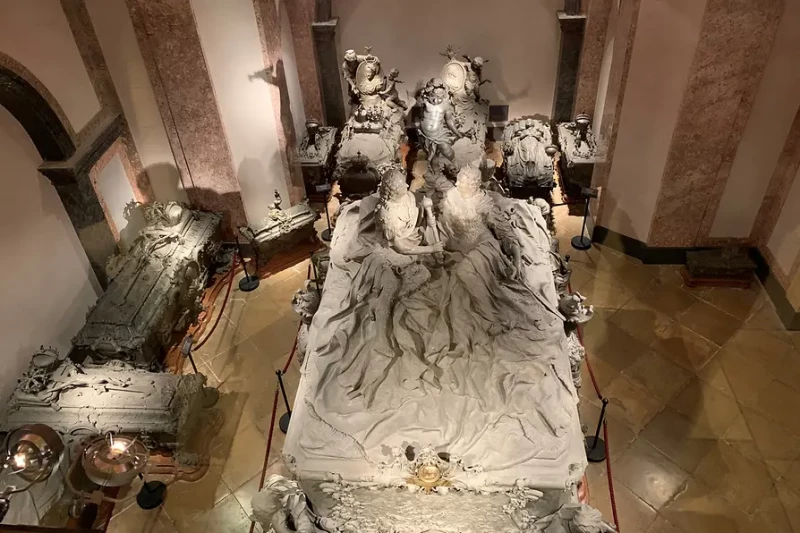
The Imperial Crypt, also known as the Imperial Burial Vault or Kaisergruft in German, is a significant historical site located beneath the Capuchin Church in Vienna, Austria. It serves as the final resting place for members of the Habsburg dynasty, one of Europe's most influential royal families, who ruled over the Austro-Hungarian Empire for centuries.
The Imperial Crypt contains the tombs of over 140 members of the Habsburg family, including emperors, empresses, and other prominent figures. The crypt's history dates back to the 17th century when Emperor Ferdinand II established it as the family's burial site. Over the centuries, the crypt has undergone several expansions and renovations, reflecting changes in architectural styles and the dynasty's status.
Visitors to the Imperial Crypt can explore its elaborate chapels and burial chambers, which are adorned with ornate decorations, marble sarcophagi, and intricate memorials. Some of the most notable tombs include those of Emperor Franz Joseph I and his wife Empress Elisabeth, also known as Sisi, whose tragic life and death continue to fascinate visitors.
The Imperial Crypt offers a unique opportunity to delve into the rich history of the Habsburg dynasty and gain insight into the customs and traditions surrounding royal burials in Europe. It is a must-visit destination for history enthusiasts and anyone interested in the fascinating legacy of the Austro-Hungarian Empire.
12 - The Imperial Treasure
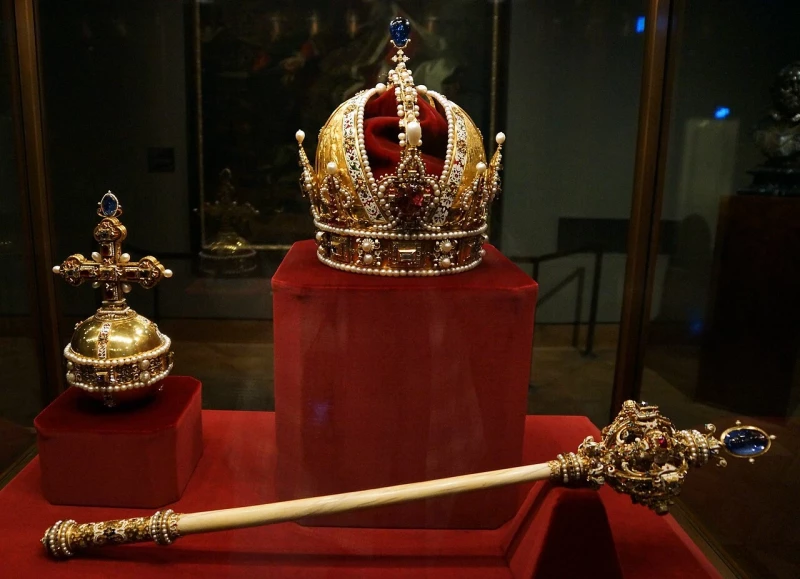
The Imperial Treasury of Vienna is one of the most significant treasures of European royalty and is housed within the Hofburg Palace in Vienna, Austria. It comprises a vast collection of precious objects, historical relics, and jewels that once belonged to the Habsburg dynasty, which ruled over the Austro-Hungarian Empire for centuries.
This treasury contains an impressive array of items, including imperial crowns, scepters, coronation robes, royal jewels, precious weapons, liturgical ornaments, reliquaries, and much more. Among the most famous pieces are the Imperial Crown of Austria, the Crown of Rudolf II, the Imperial Scepter, and the Imperial Orb, which symbolize the power and grandeur of the Habsburg Empire.
The collection of the Imperial Treasury of Vienna is displayed in specially curated rooms within the Hofburg Palace, providing visitors with the opportunity to get up close to these historical treasures and gain a deeper understanding of the history and wealth of the Habsburg dynasty.
By visiting the Imperial Treasury, visitors have the chance to immerse themselves in the opulent and fascinating world of European royalty and admire objects of priceless historical value that played a central role in the history of Austria and Europe.
13 - The Mozarthaus Museum
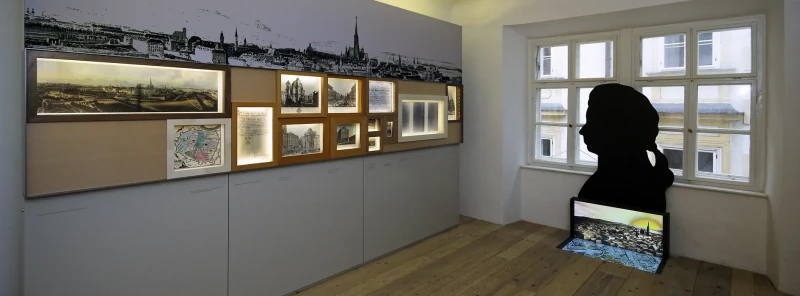
The Mozarthaus Museum is located in Vienna, Austria, and is dedicated to the life and work of the famous composer Wolfgang Amadeus Mozart. It is housed in Mozart's former residence, where he lived from 1784 to 1787 during his time in Vienna. The museum provides visitors with the opportunity to explore the environment in which Mozart lived and worked during this crucial period of his life.
Inside the museum, visitors can explore the different rooms of Mozart's apartment, restored to their original state, as well as exhibitions featuring personal items, period musical instruments, and artifacts related to the composer's life. The museum also offers information about the cultural and social life of Vienna during Mozart's time.
The Mozarthaus Museum is a must-visit for classical music enthusiasts and those interested in Mozart's history. It provides an immersive experience that helps to better understand the life and musical legacy of this Austrian genius.
14 - Hundertwasser's House
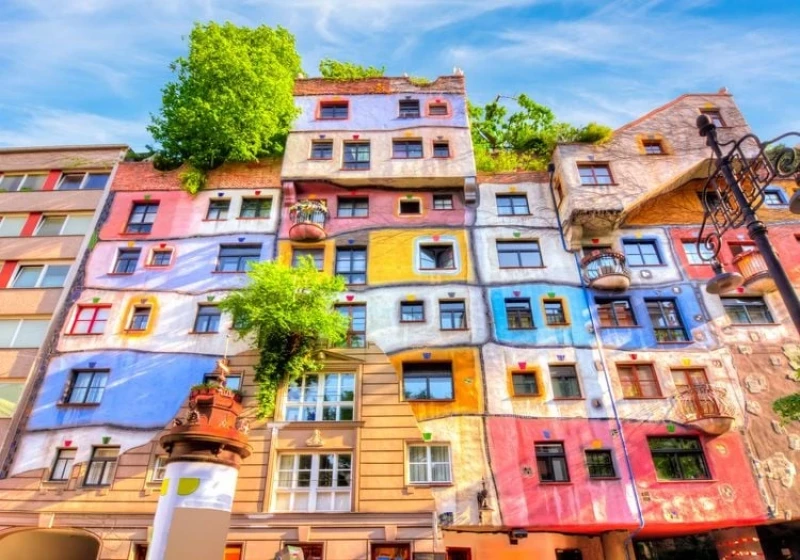
The Hundertwasser House, located in Vienna, Austria, is an iconic residential building designed by the renowned Austrian artist and architect Friedensreich Hundertwasser. Completed in 1985, it stands out for its vibrant colors, undulating lines, and incorporation of natural elements.
The building is a prime example of Hundertwasser's philosophy of "architecture in harmony with nature." It features uneven floors, trees growing from inside the rooms, and an irregular façade adorned with colorful mosaics and ceramic tiles. The design aims to break away from the monotony of traditional architecture and create a more organic and whimsical living environment.
Today, the Hundertwasser House is not only a residential building but also a popular tourist attraction in Vienna. Visitors can admire its unique exterior from the outside or even take guided tours inside to learn more about Hundertwasser's life and vision for architecture. The building stands as a testament to the artist's creativity and his belief in the integration of art and nature in everyday life.
15 - The Austrian National Library
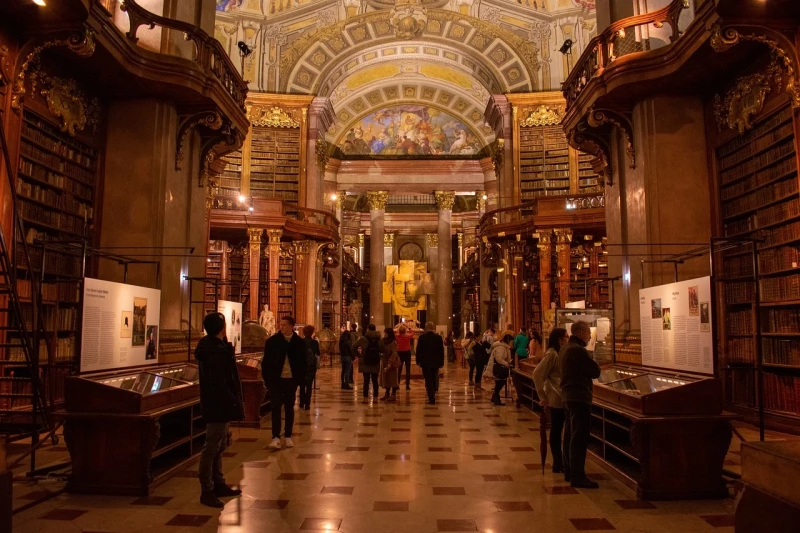
The Austrian National Library, also known as Österreichische Nationalbibliothek in German, is the national library of Austria. Located in Vienna, it is one of the largest libraries in the country and houses a rich collection of cultural resources and documents.
The library was founded in 1526 by Emperor Ferdinand I, although it was officially established as a national library in 1920 after the dissolution of the Austro-Hungarian Empire. Its collection includes millions of books, manuscripts, periodicals, maps, prints, photographs, and audiovisual recordings, covering a wide range of subjects and historical periods.
The Austrian National Library is also renowned for its special collections, such as the Habsburg Family Papyrus Collection, Mozart's manuscripts, incunabula, and rare books. As a major cultural institution, it plays a significant role in preserving Austria's literary and cultural heritage and in promoting research and education.
 Our tips for getting the most out of your experience.
Our tips for getting the most out of your experience.
Visiting the Austrian National Library is a fascinating experience for book lovers, history enthusiasts, and culture aficionados alike. Here are some tips to make the most out of your visit:
-
Plan your visit in advance: Check the library's website for opening hours, special exhibitions, and any requirements for guided tours or accessing special collections.
-
Be punctual: Arrive on time for your visit, especially if you've booked a guided tour or special access to collections. This ensures you have ample time to explore.
-
Respect the library's rules: Follow the library's regulations regarding noise levels, food and drink policies, and proper use of facilities.
-
Explore temporary exhibitions: If the library has special exhibitions on display, take the time to explore them. They can offer fascinating insights into the library's history, culture, and treasures.
-
Take a guided tour: If available, join a guided tour of the library. Guides can provide valuable information about the building's history, collections, and hidden gems.
-
Consult special collections: If you have a particular interest in a specific topic or author, inquire in advance about accessing the library's special collections. This may require prior reservation and specific protocols.
-
Take photos responsibly: While many areas of the library are beautiful and photogenic, be sure to adhere to rules regarding photography indoors. Some areas may have restrictions on shooting.
-
Enjoy the ambiance: Take the time to soak in the unique atmosphere of the library, whether in the reading rooms, exhibitions, or common spaces. It's a rare opportunity to experience a cultural treasure of significant importance.
16 - Attend a classical music concert
Attending a classical music concert in Vienna is an exceptional and unforgettable experience. As one of the world's capitals of classical music, Vienna offers a plethora of options for music enthusiasts, ranging from prestigious symphony orchestras to chamber music ensembles in historical venues.
Here are some recommendations for attending a classical music concert in Vienna:
-
Renowned concert halls: Iconic venues like the Wiener Musikverein, where the famous New Year's Concert by the Vienna Philharmonic Orchestra takes place, or the Konzerthaus, offer a varied program throughout the year.
-
Vienna State Opera (Wiener Staatsoper): Attending a performance at the Vienna State Opera is an incomparable experience. From classical operas to contemporary productions, the Viennese stage is renowned for its artistic quality.
-
Churches and cathedrals: Some churches and cathedrals in Vienna also host classical music concerts, providing an intimate and spiritual atmosphere. For example, St. Peter's Church (Peterskirche) or St. Stephen's Cathedral (Stephansdom) regularly host concerts.
-
Museums and palaces: Cultural venues like Schönbrunn Palace or Belvedere Palace sometimes organize concerts in their splendid halls, offering a unique experience combining music and historical heritage.
-
Lesser-known venues: Beyond the major establishments, Vienna is filled with smaller, lesser-known venues where chamber music ensembles regularly perform. This can offer a more intimate and authentic experience.
Attending a classical music concert in Vienna is not only an opportunity to appreciate music in one of Europe's most culturally rich cities but also a dive into the history and musical tradition that make this city a must-visit destination for music lovers worldwide.
17 - Explore Viennese cafés
Exploring Viennese cafes is a fascinating cultural experience. Vienna, Austria, is renowned for its historic cafes, where you can enjoy coffee in a unique atmosphere. Here are some aspects to consider when exploring Viennese cafes:
-
Atmosphere: Viennese cafes are known for their warm and welcoming ambiance. They are often elegantly decorated with comfortable furniture and soft lighting, creating a relaxed atmosphere conducive to socializing and relaxation.
-
Specialties: Viennese cafes offer a variety of beverages, but some are must-tries. The Wiener Melange is a blend of coffee and milk, similar to a cappuccino. The Einspänner is a black coffee served in a small glass, topped with whipped cream. The traditional Viennese coffee is also very popular, featuring black coffee with whipped cream and sugar.
-
Pastries: In addition to drinks, Viennese cafes typically offer a selection of delicious pastries. Strudels, Sachertortes (chocolate cakes), and Apfelstrudels (apple strudels) are among the classics not to be missed.
-
History: Viennese cafes have a long history dating back centuries. They have often been meeting places for artists, intellectuals, and writers, who spent hours discussing and exchanging ideas. Some cafes have retained their old-world charm and have become cultural institutions.
-
Hospitality: Viennese cafes are also places where you can spend time reading, working, or simply people-watching. They are open to everyone and are a favored spot for observing Viennese daily life.
By exploring Viennese cafes, you'll have the opportunity to discover an important aspect of Austrian culture and to experience an authentic and memorable outing.
18 - Take a carriage ride
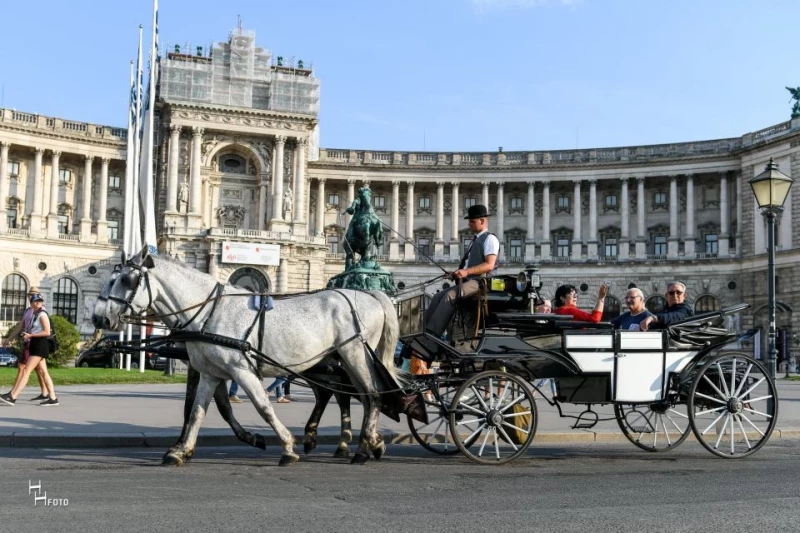
Taking a leisurely carriage ride through the enchanting streets of Vienna is an experience straight out of a fairytale. As the rhythmic clip-clop of the horse's hooves echoes against the cobblestone streets, you can't help but feel transported to a bygone era of elegance and romance.
Seated comfortably in the carriage, you're enveloped by a sense of tranquility as you glide past ornate palaces, grand cathedrals, and charming cobblestone squares. The majestic architecture of Vienna's historic buildings unfolds before you, each structure whispering stories of the city's rich and storied past.
The gentle sway of the carriage adds to the sense of serenity, allowing you to fully immerse yourself in the beauty of your surroundings. From the opulent façade of the Hofburg Palace to the picturesque lanes of the Old Town, every corner turned reveals a new marvel to behold.
As you pass by bustling cafes and quaint boutiques, locals and tourists alike pause to admire the elegant spectacle of your carriage, momentarily enchanted by the timeless allure of this age-old mode of transport.
With each passing moment, you find yourself falling deeper under the spell of Vienna's old-world charm, cherishing the simple pleasure of a leisurely carriage ride through one of Europe's most enchanting cities. And as the sun begins to set, casting a warm glow upon the city streets, you can't help but feel grateful for this magical journey through Vienna's storied past.
19 - Taste Austrian cuisine
Tasting Austrian cuisine is a gastronomic journey rich in flavors and traditions. Here's an overview of some iconic Austrian dishes not to be missed:
-
Wiener Schnitzel: This iconic dish consists of a thin slice of veal, pork, or chicken, breaded and fried to perfection. Typically served with fried potatoes and a slice of lemon, Wiener Schnitzel embodies the essence of Austrian cuisine.
-
Apfelstrudel: This delicious and comforting dessert consists of a thin, flaky pastry filled with diced apples, raisins, cinnamon, and sugar. Served warm with a dollop of whipped cream, Apfelstrudel is a must-have after an Austrian meal.
-
Sachertorte: Created in Vienna, this chocolate cake is a true institution. It features layers of chocolate sponge cake with a thin layer of apricot jam between each layer, all covered in a shiny chocolate glaze.
-
Knödel: Knödel are dumplings, often made with potatoes or bread, filled with various fillings such as mushrooms, cheese, or fruits. They can be served as a side dish or as a main course.
-
Tafelspitz: This traditional Austrian dish showcases a piece of braised beef, typically served with boiled potatoes, root vegetables, and a horseradish sauce.
-
Kaiserschmarrn: This popular dessert is a kind of thick pancake, served in pieces and usually accompanied by fruit compote or jam.
-
Goulash: While this dish is more associated with Hungarian cuisine, it's also very popular in Austria. Austrian goulash is a hearty stew made with meat (often beef), peppers, onions, and spices, served with knödel or potatoes.
Exploring Austrian cuisine, you'll discover a palette of rich and varied flavors, steeped in tradition and culinary craftsmanship. Enjoy your meal!
Vienna - Where to Stay?
For a stay in Vienna, there are several recommended neighborhoods to stay in depending on your preferences and budget. Here are some options:
-
Innere Stadt (1st district): This is the historic heart of Vienna, where you'll find many major tourist sites such as St. Stephen's Cathedral, the State Opera, and the Imperial Palace (Hofburg). Hotels in this area may be a bit more expensive, but you'll be right in the heart of the action.
-
Leopoldstadt (2nd district): Located on the banks of the Danube, this neighborhood is home to the famous Prater amusement park and offers a lively atmosphere with plenty of restaurants, bars, and cafes. You can find a range of accommodation options here, from luxury hotels to hostels.
-
Neubau (7th district): This trendy district is ideal if you're looking for a more alternative vibe with many designer shops, art galleries, and hip cafes. Accommodation in this area is often more affordable than in the historic center.
-
Mariahilf (6th district): Close to the city center, Mariahilf is known for its bustling shopping streets like Mariahilfer Strasse and its many bars and restaurants. It's a good compromise between accessibility and accommodation prices.
-
Landstraße (3rd district): This neighborhood is a bit quieter than the city center but still well-connected by public transport. It's also home to interesting sights such as the Belvedere Palace and City Park.
Whichever neighborhood you choose, be sure to check for nearby public transportation options to make getting around the city easier.
Vienna - How to get around?
To get around and explore Vienna, you have several efficient transportation options available:
-
Subway (U-Bahn): Vienna's subway system is fast, reliable, and convenient for traveling throughout the city. There are five main lines (U1, U2, U3, U4, U6) that cover most of the tourist attractions and popular neighborhoods. Subways run frequently and typically operate from 5:00 am to midnight.
-
Tram (Strassenbahn): Vienna's tram network is extensive and provides an excellent way to travel around the city center and outlying neighborhoods. Trams are also very frequent and can be more scenic for sightseeing.
-
Bus: Vienna's bus network complements the subway and trams, offering extensive coverage throughout the city, including areas less accessible by other modes of transportation. Buses also run regularly and are generally well connected to the subway and trams.
-
Bicycle: Vienna is a very bike-friendly city with numerous bike paths and a public bike rental system called "Citybike Wien." You can rent a bike at one of the many rental stations and explore the city at your own pace.
-
Walking: Many tourist sites in Vienna are within walking distance of each other, making walking an attractive option for exploring the city. You can stroll through historic streets, discover hidden corners, and soak up Vienna's unique atmosphere.
To make the most of your visit to Vienna, you may also consider purchasing a tourist card or transport pass, which often offer discounts on regular fares and free or discounted access to certain tourist attractions.
Vienna - Best period
Vienna is a captivating city to visit throughout the year, each season offering its own unique charm and experiences. Here's a breakdown of the best times to visit Vienna based on different preferences:
-
Spring (April - May):
- Spring in Vienna brings milder temperatures and blooming flowers, making it a delightful time to explore the city's parks and gardens.
- The Easter season in April is particularly festive in Vienna, with colorful markets, traditional events, and spring decorations adorning the city.
- May is also a great time to visit before the peak tourist season, with pleasant weather and fewer crowds.
-
Summer (June - August):
- Summer is peak tourist season in Vienna, with longer days and warmer temperatures.
- Many outdoor events, festivals, and concerts take place during the summer months, including the famous Vienna Film Festival and open-air concerts in various parks.
- Be prepared for larger crowds and higher prices for accommodations during this time.
-
Fall (September - October):
- Fall is another pleasant time to visit Vienna, with mild temperatures and fewer tourists compared to the summer months.
- The city's parks and gardens transform into a kaleidoscope of autumn colors, providing picturesque backdrops for sightseeing and leisurely walks.
- September is also a prime time for cultural events and exhibitions, offering enriching experiences for visitors.
-
Winter (November - February):
- Winter in Vienna is magical, especially during the holiday season when the city is adorned with festive decorations and Christmas markets.
- The famous Viennese Christmas markets, such as the Christkindlmarkt at Rathausplatz, offer an enchanting atmosphere with traditional crafts, seasonal treats, and live music.
- January and February are quieter months with fewer tourists, making it a great time to experience Vienna's cultural attractions and indoor activities, such as visiting museums and attending classical concerts.
Ultimately, the best time to visit Vienna depends on your personal preferences, whether you prefer mild weather and fewer crowds in the shoulder seasons or vibrant festivities and cultural events during the peak tourist season.
